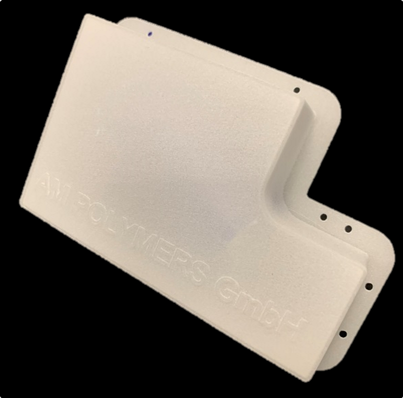AM POLYMERS GmbH expands its powder portfolio for laser sintering with a new polypropylene powder. In contrast to most of the materials on the market, the material has exceptionally high elongation at break of more than 200 %. At the same time, the material has excellent processing conditions on common machine systems.

AM POLYMERS GmbH presents its fourth series material from the ROLASERIT® family at FORMNEXT 2019 in Frankfurt and starts the BETA phase for the newly developed ROLASERIT® PP03O. This extends the material range for laser sintering to include a material with outstanding ductility and injection moulding properties. For the first time, a lower elongation at break has not to be accepted, as is generally the case in additive manufacturing.

With an elongation at break of more than 200 %, the material is a pioneering role in the field of materials for laser sintering. Most materials only have elongations at break in the range of less than 50 %. The processing of the material has already been tested successfully and without problems on common laser sintering systems. In accordance with the company philosophy of selling only plug-and-play materials, only short running-in times on the machines are necessary. Thus, the production of customer parts is possible within a few days. The application spectrum of manufactured components is diverse and ranges from simple housings to function-integrated parts with film hinges. Based on its high ductility, the ROLASERIT® PP03O is also ideally suited for series production.

Visit us at FORMNEXT 2019 booth 11.1 A79 to learn more about ROLASERIT® PP03O.
In addition to polypropylene PP01, polyethylene PEGR01 and TPU PB01, PP03O now forms the fourth thermoplastic powder available as series material, which AM POLYMERS has developed for laser sintering or for powder bed fusion and sells under the brand name ROLASERIT®.
AM POLYMERS GmbH will also be presenting other powder materials at FORMNEXT 2019. The newly developed ROLASERIT® PP04 is designed to offer a polypropylene with increased stiffness and strength requirements compared to PP01 and PP03. The ROLASERIT® PA FLEX01 is intended for applications with a requirement profile with low stiffness and simultaneously high ductility in laser sintering. The polyamide material has been specifically optimized for this special application.
AM POLYMERS GmbH with a headquarters in Willich was founded in 2014. The company is specialized in the development, production and distribution of laser sintering materials. The company’s team can look back on many years of experience in the field of additive manufacturing. The founders, Dr.-Ing. Andreas Wegner and Prof. Dr.-Ing. habil. Gerd Witt have twelve and more than twenty years of experience in laser sintering of plastics. Timur Ünlü, a specialist of many years experience in the field of powder production, joined the company in 2018. Since 2019 a new production and development site for the production of plastic powders has been established in Willich.
In addition to the commercialized products, other important standard thermoplastics such as PA6 or PBT are developed for laser sintering. The current state of development already shows promising properties of these future products.
Contact:
AM POLYMERS GmbH
Dr.-Ing. Andreas Wegner
Hanns-Martin-Schleyer-Straße 9e
47877 Duisburg
Germany
tel.: +49 174 2174251
email: info@am-polymers.de
web: https://www.am-polymers.de
The post AM POLYMERS GmbH: New Polypropylene ROLASERIT PP03O for Laser Sintering with 200 % Elongation at Break and Other New Materials appeared first on 3DPrint.com | The Voice of 3D Printing / Additive Manufacturing.





